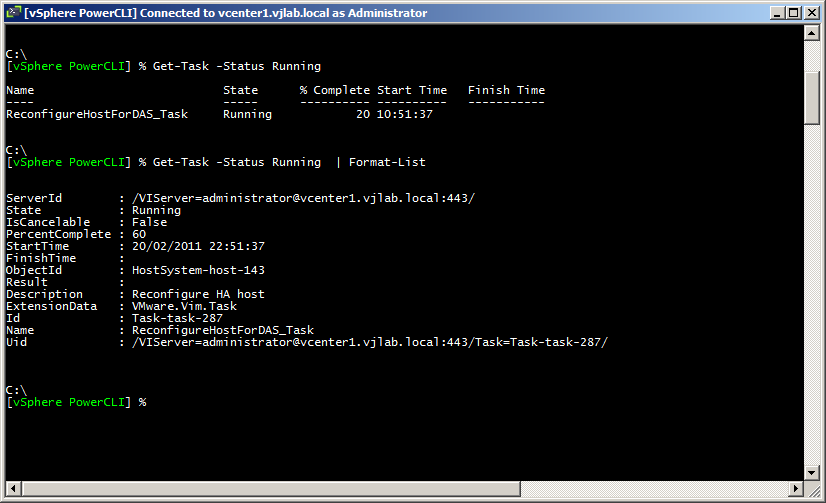Reconfigure an ESX(i) for HA using vSphere PowerCLI
Anyone with some experience and knowledge about VMware HA knows how to perform a Reconfigure for HA operation in a host from the vSphere client and I’m no exception to that rule. However I never did with PowerCLI.
I created a new cluster in my homelab with a problem in one of the hosts, I fixed the problem, put my mind to work and after an hour or so digging through PowerCLI and the vSphere API Reference Documentation I came up with the following easy way to do it.
First we are going to create a variable that contained the configuration of the ESXi I wanted to reconfigure.
C:\
[vSphere PowerCLI] % $vmhost = Get-VMHost esxi06.vjlab.local
C:\
[vSphere PowerCLI] %
C:\
[vSphere PowerCLI] % $vmhost | Format-List
State : Connected
ConnectionState : Connected
PowerState : PoweredOn
VMSwapfileDatastoreId :
VMSwapfilePolicy : Inherit
ParentId : ClusterComputeResource-domain-c121
IsStandalone : False
Manufacturer : VMware, Inc.
Model : VMware Virtual Platform
NumCpu : 2
CpuTotalMhz : 5670
CpuUsageMhz : 869
MemoryTotalMB : 2299
MemoryUsageMB : 868
ProcessorType : Intel(R) Core(TM)2 Quad CPU Q9550 @ 2.83GHz
HyperthreadingActive : False
TimeZone : UTC
Version : 4.1.0
Build : 260247
Parent : cluster3
VMSwapfileDatastore :
StorageInfo : HostStorageSystem-storageSystem-143
NetworkInfo : esxi06:vjlab.local
DiagnosticPartition : mpx.vmhba1:C0:T0:L0
FirewallDefaultPolicy :
ApiVersion : 4.1
CustomFields : {[com.hp.proliant, ]}
ExtensionData : VMware.Vim.HostSystem
Id : HostSystem-host-143
Name : esxi06.vjlab.local
Uid : /VIServer=administrator@vcenter1.vjlab.local:443/VMHost=HostSystem-host-143/
C:\
[vSphere PowerCLI] %
Next with the cmdlet Get-View I retrieved the .NET objects of the host ID and stored them in another variable.
C:\
[vSphere PowerCLI] % Get-View $vmhost.Id
Runtime : VMware.Vim.HostRuntimeInfo
Summary : VMware.Vim.HostListSummary
Hardware : VMware.Vim.HostHardwareInfo
Capability : VMware.Vim.HostCapability
ConfigManager : VMware.Vim.HostConfigManager
Config : VMware.Vim.HostConfigInfo
Vm : {}
Datastore : {Datastore-datastore-144}
Network : {Network-network-11}
DatastoreBrowser : HostDatastoreBrowser-datastoreBrowser-host-143
SystemResources : VMware.Vim.HostSystemResourceInfo
Parent : ClusterComputeResource-domain-c121
CustomValue : {}
OverallStatus : red
ConfigStatus : red
ConfigIssue : {0}
EffectiveRole : {-1}
Permission : {}
Name : esxi06.vjlab.local
DisabledMethod : {ExitMaintenanceMode_Task, PowerUpHostFromStandBy_Task, ReconnectHost_Task}
RecentTask : {}
DeclaredAlarmState : {alarm-1.host-143, alarm-101.host-143, alarm-102.host-143, alarm-103.host-143...}
TriggeredAlarmState : {}
AlarmActionsEnabled : True
Tag : {}
Value : {}
AvailableField : {com.hp.proliant}
MoRef : HostSystem-host-143
Client : VMware.Vim.VimClient
C:\
[vSphere PowerCLI] % $esxha = Get-View $vmhost.Id
Now through the $esxha variable I invoked the method ReconfigureHostForDAS to reconfigure the ESXi, this method is part of the HostSystem object and its description can be found herein the vSphere API reference.
As it can be seen in the above screenshot, the task is displayed in the vSphere client. You can also monitor the operation with the Get-Task cmdlet.
Finally I created the below script to simplify things in the future.
# Reconfigure-VMHostHA.ps1
# PowerCLI script to reconfigure for VMware HA a VM Host
#
# Juan Manuel Rey - juanmanuel (dot) reyportal (at) gmail (dot) com
# http://blog.jreypo.io
#
param([string]$esx)
$vmhost = Get-VMHost $esx
$esxha = Get-View $vmhost.Id
$esxha.ReconfigureHostForDAS()
Juanma.



Comments